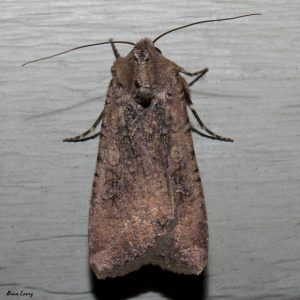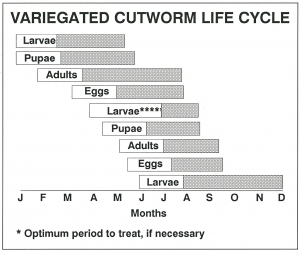Peridroma saucia – Variegated Cutworm (VCW)


Introduction
The larvae of this species, and other related cutworms and armyworms, feed on mint foliage. VCW is a very common pest. It has two overlapping generations per year.
Cutworms overwinter as partially mature larvae, begin feeding in early spring, and then mature an d pupate in April/May. Adult moths emerge in May/early June and deposit eggs on the underside of leaves.
d pupate in April/May. Adult moths emerge in May/early June and deposit eggs on the underside of leaves.
Adult moths are large and brown to reddish-brown with dark spots on the wings. Eggs hatch in 4-7 days and larvae feed on foliage for 4-6 weeks before dropping to the ground to pupate. Mature larvae are up to 1.5” long and are a mottled color with a yellow band along the side.
If treatment threshold is reached, larvae should be controlled before they start feeding heavily in the 4th instar.
Sampling
- If possible, place sticky traps baited with a pheromone lure near fields starting in April. These traps are used to detect flights of adult moths. The pheromone only attracts male moths, but can give an indication of VCW activity near a field. Use the mint pest alert newsletter to learn about regional trends and developmental models. Degree-day models provide estimates of when VCW larvae will be present in fields.
- Scout for larvae from late June through post-harvest. Young larvae can be found in the foliage. Perform sweep net sampling to estimate larval density in a specific planting. Walk in a straight line and sweep the net back and forth 10 times. Examine the net and take note of how many larvae are present. Also note the abundance of parasitoids and predators – this is important because parasitized larvae consume less foliage. if desired, one can remove head capsules of VCW larvae and pull, if the cutworm has been parasitized you will see a small larvae inside of the body capsule. Repeat the process at 5 different locations within the field. If your field is larger than 30 acres, perform another sweep sample (40A = 6 sites, 50A = 7 sites, etc.). Sweep net sampling works best on cool, overcast mornings.
- If large larvae are suspected, or if the canopy is dense, it is typically easier to shake stems to dislodge larvae and inspect the soil surface. Shake plants at several sites throughout the field and carefully look for larvae in soil cracks, under leaves, and in old, brown, curled leaves. Treatment is recommended when larvae reach two to four per ft2.
- There has been a large amount of OSU research dedicated to VCW in peppermint and spearmint. One available tool is the sequential sampling application developed to estimate damage based on larval counts. Access the tool here: http://ippc2.orst.edu/mint/msim.html
Management
- Biological control of VCW by naturally occurring predators and parasites is actually a viable strategy in mint production, even moreso than other commodities. These ‘good bugs’ should be considered beneficial allies because they suppress cutworm populations. In fact, up to 90% parasitism has been documented in Oregon fields.
- Unfortunately, the efficacy of biologically-based insecticides such as Bt is not great against VCW in mint. This is because thorough coverage is difficult.
- Consumption of mint terpenes may detoxify some insecticides, which adds to the difficulty of controlling VCW and other cutworms. Management decisions should be based on field sampling, oil prices, timing, etc.
- Consult the PNW handbook for the most current list of registered chemical controls for cutworms in mint. Always obey the label.

